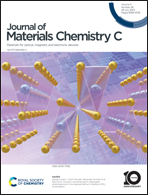Reporting a novel visible near-infrared {Tb3}[Ga0.1Sc1.9](Al3)O12 single crystal for Faraday isolators†
Abstract
The Tb3Sc2Al3O12 single crystal is a well-known magneto-optical material for visible near-infrared Faraday isolators. Unfortunately, its application is severely restricted owing to its drawbacks in bulk crystal growth. The traditional Tb3Ga5O12 crystal shows excellent bulk growth attributes. A small substitution of Sc by Ga could potentially improve the Tb3Sc2Al3O12 growth characteristics, while preserving its superior magneto-optical properties. Therefore, in this work, a novel {Tb3}[Ga0.1Sc1.9](Al3)O12 crystal has been designed by integrating the advantages of Tb3Sc2Al3O12 and Tb3Ga5O12 crystals. A high-quality crack-free {Tb3}[Ga0.1Sc1.9](Al3)O12 single crystal is successfully grown by the Czochralski method for the first time. The full width at half maximum of the rocking curve is as small as 27.18′′, indicating high crystallinity of the as-grown crystal. In comparison with the Tb3Ga5O12 crystal, the {Tb3}[Ga0.1Sc1.9](Al3)O12 crystal possesses a better optical transmittance, a lower weak absorption coefficient, and a larger Verdet constant. Therefore, the novel {Tb3}[Ga0.1Sc1.9](Al3)O12 single crystal is very promising for visible near-infrared Faraday applications.
O12 single crystal for Faraday isolators](/en/Image/Get?imageInfo.ImageType=GA&imageInfo.ImageIdentifier.ManuscriptID=D3TC01459B&imageInfo.ImageIdentifier.Year=2023)
- This article is part of the themed collection: #MyFirstJMCC


 Please wait while we load your content...
Please wait while we load your content...